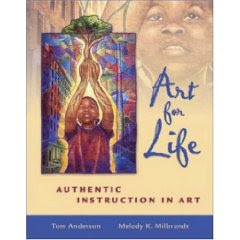- This technique is well suited for design using overlapping of shapes and colors, positive and negative shapes, value contrast, pattern, and texture
- Cut and arrange the large shapes in a motif first
- Overlapping of shapes is a major feature of collage making
- Guide students to use eye-catching materials (i.e. foils, cellophane, and shiny plastic) only as points of emphasis
- Encourage students to use uneven repetition
- Use informal (asymmetrical) balance instead of formal (symmetrical) balance
- Use discarded magazines as paste-applying surfaces
TISSUE-PAPER COLLAGE
- Adhere tissue to the background using undiluted liquid laundry starch
- Work with lighter color tissue first
- Apply a layer of starch on the background, then apply tissue, then apply another layer of starch
MOSAICS
- Tesserae - the little colored pieces
- Teaches that wholes are made of parts - important concepts in math, science, and social studies
- Examples of mosaic art: San Vitale in Rome, Gaudi's Cathedral in Barcelona, Simon Rodia's Watts Towers in Los Angeles, and the avenues of Rio de Janeiro
- Store tesserae by color in shoe boxes
- It is best to begin on the outer edge and work inward toward center
- Employ several values of a color in larger areas






No comments:
Post a Comment